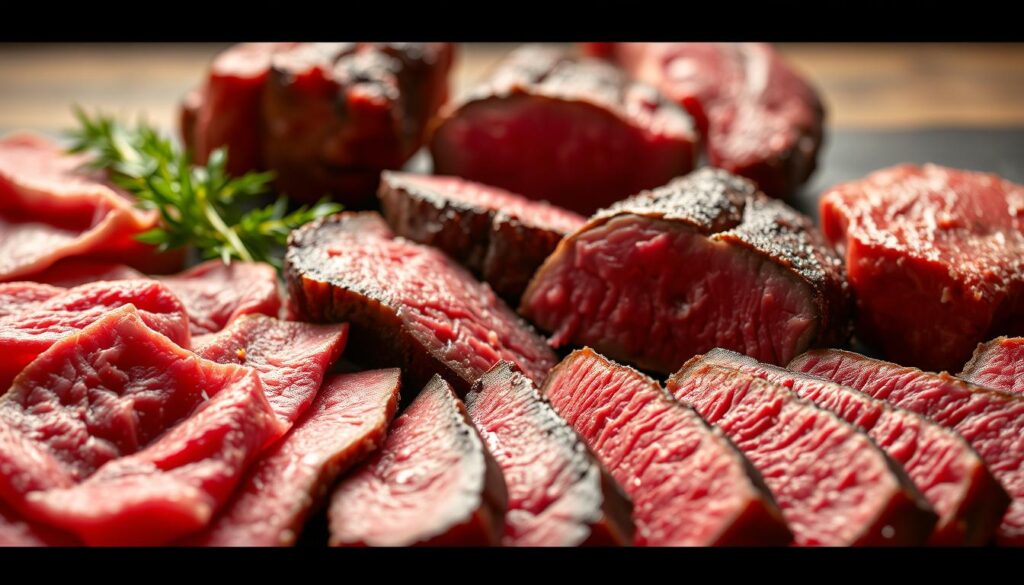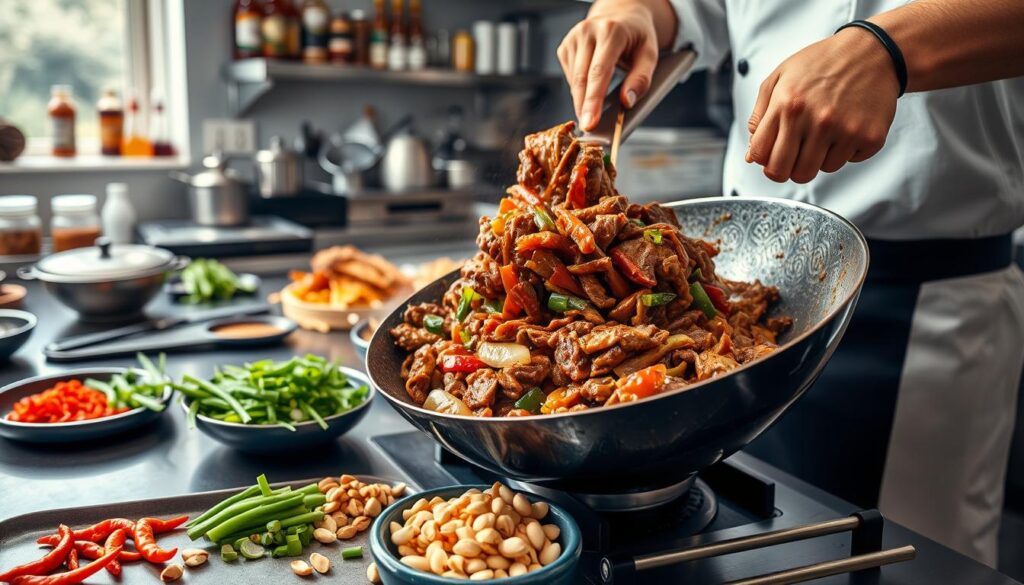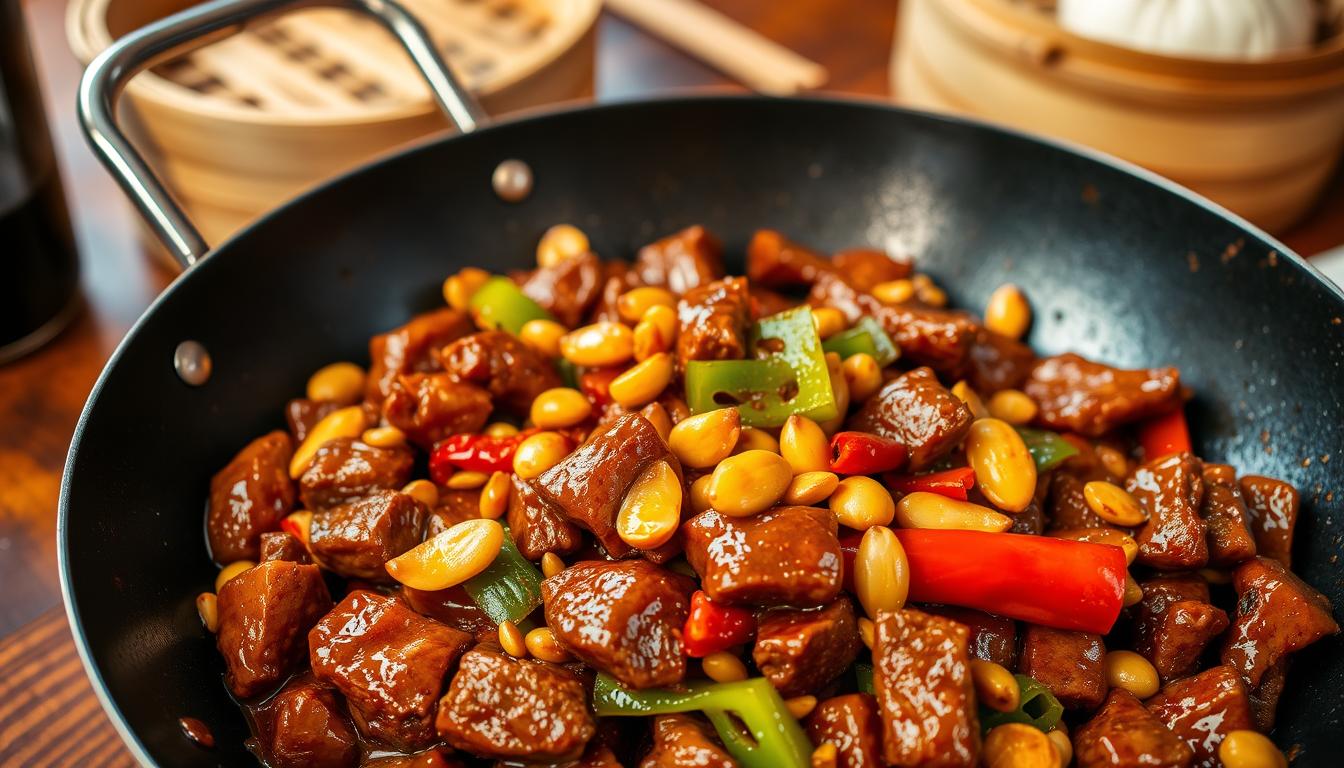What Is Kung Pao Beef? Ingredients Flavor and How to Make It
The first time I tasted Kung Pao beef, it was like a flavor explosion. It changed how I saw Chinese cuisine. The sizzling sounds, the spicy aroma, and the mix of heat and savory notes won my heart.
Kung Pao beef is a vibrant dish that combines tender beef, crunchy peanuts, and spicy chilies. It’s more than a meal; it’s a journey through Sichuan cuisine. It offers a spicy and complex taste that takes you to China’s heart.
Exploring Kung Pao beef, you find a dish that mixes protein, veggies, and a special sauce. The ingredients create a perfect blend of textures and tastes. This dish is a hit in Chinese-American restaurants across the U.S.
Table of Contents
What Is Kung Pao Beef
Kung pao beef is a vibrant dish from Chinese cooking. It comes from Sichuan province, famous for its bold flavors. These flavors excite and challenge our taste buds.
Origins in Sichuan Cuisine
The story of kung pao beef starts in southwestern China’s Sichuan region. This area is known for its unique cooking style. It’s all about:
- Intense spicy flavors
- Complex sauce combinations
- Unique cooking techniques
Evolution from Traditional Chicken to Beef
At first, kung pao beef was made with chicken. Chefs then changed it to beef for a heartier option. This change made the dish more appealing to many while keeping its core flavors.
Cultural Significance in Chinese Cooking
Kung pao beef is more than food; it’s a story of Chinese cooking. It shows the art of mixing flavors, textures, and ingredients. Its fame has introduced Sichuan cuisine to the world.
From its start to its fame today, kung pao beef shows the creativity and richness of Chinese food.
Essential Ingredients for Authentic Kung Pao Beef
To make authentic kung pao beef, you need the right ingredients. They add depth and complexity to this Sichuan dish. Knowing the ingredients is key to getting the true flavor of this recipe.
The base of kung pao beef is high-quality protein. Flank steak is the best choice, with its perfect mix of tenderness and taste. To make this meat delicious, you’ll need a few important things:
- Protein Enhancers:
- Soy sauce
- Rice vinegar
- Cornstarch
- Baking soda (for tenderizing)
- Flavor Makers:
- Sichuan peppercorns
- Hot chili paste
- Honey
- Fresh garlic
- Ginger
- Texture and Crunch:
- Bell peppers
- Green onions
- Roasted peanuts
The secret to great kung pao beef is balancing these ingredients. Sichuan peppercorns add a unique numbing heat. The mix of chili paste and honey gives a sweet-spicy taste that’s key to this dish.
Every ingredient is important for the dish’s complex flavor. By choosing and mixing these ingredients well, you can turn simple items into a fantastic meal. This meal captures the essence of Sichuan cuisine.
The Secret Behind Kung Pao’s Signature Sauce
To make a true kung pao beef recipe, you must master the sauce. This sauce is a mix of flavors that turns simple ingredients into a spicy kung pao beef dish.
The sauce’s magic comes from its balanced ingredients. Each part adds to the flavor that makes kung pao beef so loved.
Balancing Sweet, Spicy, and Savory Elements
Your sauce needs a mix of tastes. The main ingredients are:
- Soy sauce for umami depth
- Rice vinegar for tanginess
- Sugar to balance heat
- Cornstarch for thickening
Role of Sichuan Peppercorns
Sichuan peppercorns are key to the dish’s unique mala sensation. This sensation is a mix of numbness and spiciness. It makes the kung pao beef stand out.
Sauce Preparation Techniques
Making the perfect sauce needs care. Whisk your ingredients well to avoid lumps. Cook the sauce until it’s glossy and thick, sticking well to beef and veggies.
Pro tip: Prepare your sauce ingredients before cooking. This makes cooking your spicy kung pao beef easier and less stressful.
Selecting and Preparing the Perfect Cut of Beef

Choosing the right cut of beef is key for a great kung pao beef recipe. Flank steak is the top pick for both home cooks and chefs. It has a strong beef flavor and texture that makes your dish taste like it’s from a restaurant.
Meat selection is the first step in making kung pao beef. Flank steak has several benefits:
- Lean and muscular texture
- Bold, intense beef flavor
- Quick cooking properties
- Ability to absorb marinades effectively
If you can’t find flank steak, other cuts can work too. Sirloin and skirt steak are good substitutes. Look for a cut that’s lean, tender, and can be sliced against the grain for tenderness.
When preparing the beef, slice it thinly and evenly. Try for pieces about 1/4 inch thick, cutting against the grain. This way, each bite is tender and the meat soaks up the spicy sauce well.
The Art of Marinating Kung Pao Beef
Marinating is key to making a great kung pao beef recipe. The right mix of ingredients turns regular beef into a tender, flavorful dish. It captures the true taste of Chinese cooking.
Learning to marinate beef for kung pao can boost your cooking skills. It’s all about picking the right ingredients and techniques. These help tenderize the meat and bring out its natural flavors.
Traditional Marination Methods
For authentic kung pao beef, you need a special mix:
- Soy sauce for depth of flavor
- Rice wine for tenderizing
- Cornstarch for a protective coating
- Sesame oil for aromatic richness
Tenderizing Techniques
Chefs use certain methods to keep beef tender:
- Baking soda treatment to break down protein fibers
- Gentle massage of marinade into meat
- Slicing beef against the grain
Timing and Temperature Considerations
| Marination Aspect | Recommended Practice |
|---|---|
| Minimum Marination Time | 30 minutes |
| Maximum Marination Time | 2 hours |
| Ideal Refrigeration Temperature | 40°F (4°C) |
Pro tip: Always marinate beef in a non-reactive container and keep it refrigerated. This prevents bacterial growth and keeps flavors strong.
Essential Cooking Techniques and Tips

To make kung pao beef, you need to learn a few key cooking skills. These skills turn simple ingredients into a dish that’s truly special. The secret to a great spicy kung pao beef is mastering the art of stir-frying at high heat.
Your cooking should focus on timing and keeping the temperature right. Stir-frying at high heat brings out deep flavors and keeps the beef tender. Start by getting all your ingredients ready before you start cooking. This is called mise en place and makes cooking smoother.
- Use a wok or large skillet for optimal heat distribution
- Slice beef against the grain for maximum tenderness
- Keep ingredients moving constantly to prevent burning
- Cook beef in small batches to maintain high temperature
When cooking spicy kung pao beef, the order of steps is important. First, quickly sear the beef to keep its juices in. Then, take it out of the pan. Next, stir-fry the garlic and ginger, add the veggies, and put the beef back in just before you’re done. This way, all the flavors mix well without overcooking the beef.
Managing the temperature is what makes kung pao beef go from good to great. You want your veggies to be crisp, the meat to be just right, and the sauce to stick to everything perfectly.
Vegetable and Peanut Components
Vegetables and peanuts are key in making authentic kung pao beef. They add flavor and balance to the dish. These ingredients are not just extras but are vital to the dish’s character.
Traditional Vegetable Selection
The dish includes a mix of colorful vegetables. These add both beauty and health to the meal. Traditional choices are:
- Crisp green bell peppers
- Bright red bell peppers
- Sliced green onions
- Zucchini (optional modern variation)
Peanuts: The Textural Powerhouse
Peanuts do more than just decorate the dish. They add a critical textural contrast that makes the dish better. Roasted and chopped, they offer:
- A satisfying crunch
- Nutty, rich flavor
- Additional protein
- Visual and textural complexity
Choose roasted, unsalted peanuts for the traditional taste of this Chinese dish.
Serving Suggestions and Accompaniments
When you make your kung pao beef, picking the right sides can make it even better. The classic choice is steamed white rice. It balances the spicy flavors and soaks up the tasty sauce.
Here are some tips for serving your kung pao beef:
- Steamed jasmine or long-grain white rice
- Chinese egg noodles
- Cauliflower rice for a low-carb option
- Stir-fried vegetables like bok choy or broccoli
To make your dish look great, add:
- Chopped green onions
- Toasted sesame seeds
- Extra roasted peanuts
- Thin sliced red chili peppers
For a full meal, try serving kung pao beef with light starters. Spring rolls or cucumber salad are good choices. The goal is to have a balanced plate that matches the bold flavors of the main dish.
Pro tip: Serve immediately after cooking to keep the beef and veggies crunchy.
Health Benefits and Nutritional Information
Kung pao beef is not just tasty; it’s also good for you. It has protein, veggies, and important nutrients. These make it a great choice for a healthy diet if eaten wisely.
The beef in kung pao beef is packed with high-quality protein. This is key for building muscles and keeping your body working right. A single serving has about 20-25 grams of protein. This makes it a top pick for those looking for protein in their meals.
- Protein content supports muscle health
- Vegetables provide essential micronutrients
- Sichuan peppercorns offer possible anti-inflammatory benefits
It’s important to think about nutrition when eating kung pao beef. While it tastes great, it can have a lot of sodium and calories. To make it healthier, try these tips:
- Choose leaner beef cuts
- Use less oil
- Add more veggies
- Watch how much you eat
Pro tip: Making kung pao beef at home lets you control what goes into it. This way, you can make a meal that’s both healthy and full of flavor.
Knowing about kung pao beef’s nutrition helps you enjoy it as part of a healthy diet. You get to savor its spicy taste and its health perks.
Storage and Reheating Guidelines
Keeping your kung pao beef recipe fresh is key. After you’ve enjoyed it, you’ll want the leftovers to taste just as good. Proper storage and reheating are essential.
Here’s how to store leftover kung pao beef:
- Use an airtight container to prevent moisture loss
- Refrigerate within 2 hours of cooking
- Store in the refrigerator for up to 4 days
Knowing how to keep kung pao beef fresh after refrigeration is important. The secret is gentle reheating. This keeps the meat tender and the sauce flavorful.
Here are the best reheating methods:
- Skillet Method: Sauté over medium heat, stirring frequently
- Wok Technique: Quick stir-frying to restore original texture
- Microwave Option: Use low power and cover to prevent drying
Always check the beef’s internal temperature reaches 165°F (74°C) for safety. Throw away any leftovers that smell bad or look spoiled.
Pro tip: Add a little water or extra sauce when reheating. This helps keep the dish moist and prevents the beef from getting tough.
Conclusion
Learning about kung pao beef is more than just a recipe. It’s diving into a rich culinary tradition. This tradition brings bold flavors and exciting textures to your meals.
The journey through Szechuan kung pao beef shows a dish that perfectly balances spices, meat, and vegetables. It’s all about precision.
Now, you can make this classic Chinese dish at home. You know how to pick the right beef and make the perfect sauce. This guide has given you the skills to turn simple ingredients into a special meal.
Whether you love cooking or exploring international foods, kung pao beef is a great start. It lets you play with flavors and spice levels. You can make it your own.
With practice and passion, you’ll soon make a Szechuan kung pao beef that will wow everyone. It’s a dish that impresses.
Remember, cooking is always a journey of learning. Every time you make this dish, you’ll get better. You’ll appreciate the balance of ingredients that makes kung pao beef unforgettable.
FAQ
What is Kung Pao Beef?
Is Kung Pao Beef very spicy?
What cut of beef works best for Kung Pao Beef?
How is Kung Pao Beef different from Kung Pao Chicken?
What are the key ingredients in Kung Pao Beef?
Is Kung Pao Beef healthy?
Can I make Kung Pao Beef less spicy?
What should I serve with Kung Pao Beef?
How long can I store leftover Kung Pao Beef?
There are no reviews yet. Be the first one to write one.

